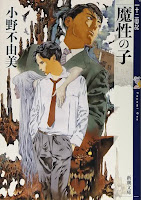Kate: Book II of Hills of Silver Ruins introduces the “haunted house” nature of Asen’s court. A horror element creeps through these chapters.
Parts of Ono's books are rather like suspense meets
splatter-fest, especially considering Taiki's prequel (or "other-quel") The Demon Child. According
to the manga I read, Japan has both suspense and splatter horror. Does
the Hitchcock/Shyamalan suspense approach take precedence or gore? Do the two genres fall into
distinct categories as in the United States (high versus low art) or do the
folks who produced Godzilla have a more flexible view of horror?
Eugene: I don't know that any one horror genre takes precedence. There's something for everybody. When manga and anime started making waves outside of Japan a half century ago, the often explicit nature of the material quickly caught everybody's attention. The blood and gore has been there all along, with the "Pinky Violence" exploitation flicks taking off in the late 1960s. Anything Hollywood could do, Japanese filmmakers could do (on a fraction of the budget), except when they were actually forbidden by statute.
Observes Donalf Richie, "American pornography is kept forever on its elemental level because, showing all, it need do nothing else; Japanese eroductions [sic] have to do something else since they cannot show all."
On-screen violence wasn't prohibited so it flourished. Some
critics point to the last scene in Sanjuro by Akira Kurosawa,
during which a malfunctioning squib produced a spray of blood that afterwards
became de rigueur.
Then there's the trend of taking an established genre like magical girl or isekai and turning it dark. Puella Magi Madoka Magica did this to perfection, though Magical Girl Lyrical Nanoha went there a decade earlier. I previously described Fruits Basket as Anne of Green Gables with every other chapter written by Stephen King. I think it'd be more accurate to describe Fruits Basket as dropping Anne Shirley into an early 19th century gothic romance, the crazy aunt in the attic and all that (but with a bunch of happy endings).




No comments:
Post a Comment